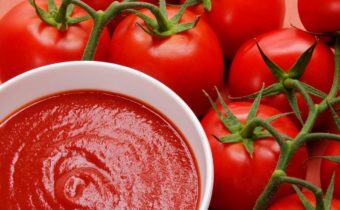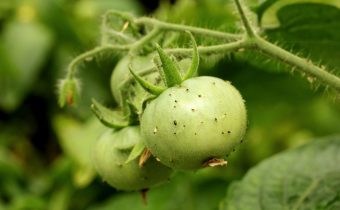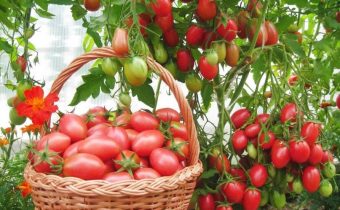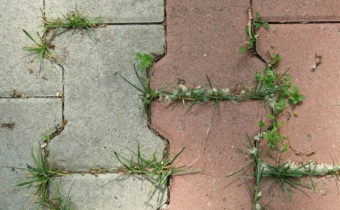Chicken droppings for tomatoes - the key to high yields
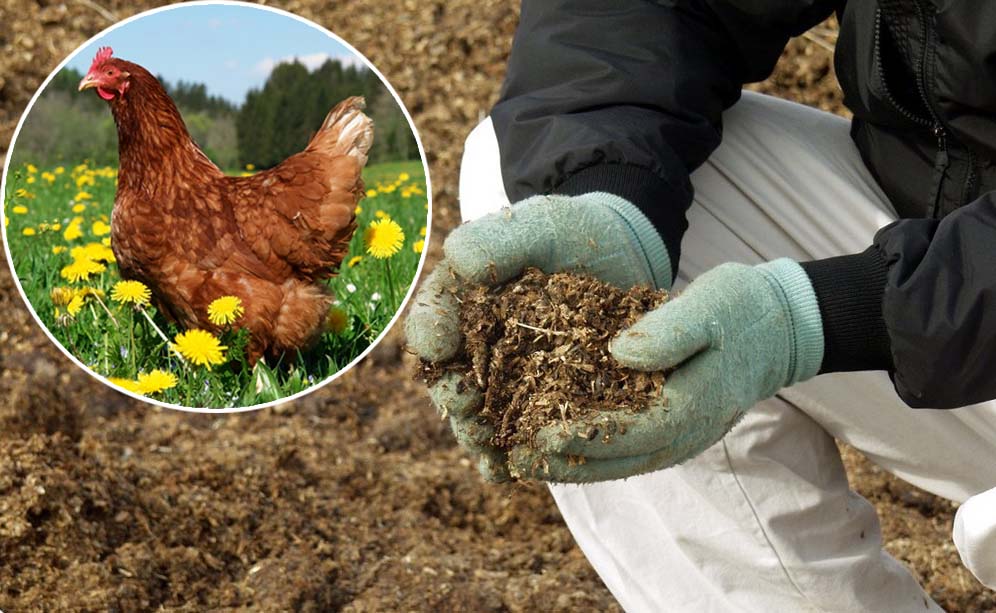
Litter from domestic chickens has long been used as a fertilizer for tomatoes. Experienced gardeners know that chicken manure has a very strong and aggressive action, and illiterate use of it instead of benefit can harm the plants. To find out in what time and in what quantities this substance can be applied this article will help.
What is the use
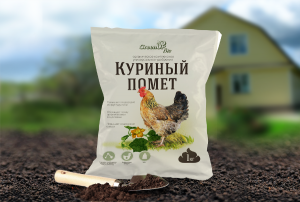 Bird droppings have a unique chemical composition, similar to some ready-made mineral supplements. In addition to the high nitrogen content typical of all types of manure, chicken contains many other important trace elements that have a positive effect on the growth and development of tomatoes:
Bird droppings have a unique chemical composition, similar to some ready-made mineral supplements. In addition to the high nitrogen content typical of all types of manure, chicken contains many other important trace elements that have a positive effect on the growth and development of tomatoes:
- potassium;
- potassium oxide;
- phosphorus;
- phosphoric acid;
- calcium;
- magnesium;
- lime.
In addition, the composition of manure from "domestic birds" includes such rare trace elements as:
- copper;
- zinc;
- sulfur;
- manganese;
- cobalt.
A feature of chicken manure is that all these substances are contained in it, in an easily digestible form for tomato plants, form.
Advantages and disadvantages of fertilizer
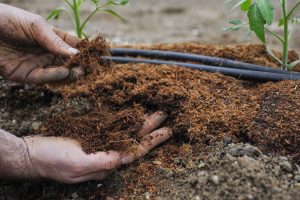 The advantages of using chicken manure include the following points:
The advantages of using chicken manure include the following points:
- contains all the necessary trace elements for normal growth and development of tomatoes at all stages of vegetation;
- unlike mineral fertilizers, it is not washed out quickly from the soil;
- after application to the soil has a positive effect for another 2-3 years;
- improves the structure and composition of the soil;
- restores soil microflora;
- due to the content of a large amount of lime reduces soil acidity;
- environmentally friendly and safe;
- plants fed with this fertilizer have increased resistance to diseases and adverse environmental conditions;
- significantly accelerates the ripening of tomatoes on the bush;
- when properly applied, it increases the yield of tomatoes by 40%;
- does not burn the root system of plants;
- widely available, cheap and easy to use.
In contrast to such a huge number of advantages, this natural fertilizer has some features and disadvantages:
- fresh is not suitable for entering into the soil, and can only be used for the preparation of infusions or solutions;
- in case of improper keeping of birds, it can be a source of such diseases as: E. coli and salmonellosis (it is dangerous for humans, and not for tomatoes);
- application without compliance may lead to the accumulation of nitrates in tomatoes;
- not suitable for feeding tomato seedlings due to the content of uric acid;
- when heated, it emits an unpleasant odor caused by the content of ammonia and hydrogen sulfide, therefore, manure should be stored away from the living quarters.
- not suitable for organizing warm ridges for tomatoes, as ammonia has a depressant effect on plants.
In what form is used and methods of application
Chicken manure can be used both fresh and processed. On the basis of it, it is possible to prepare nutritional compost mixture and various liquid solutions and infusions.Today, on the shelves of garden shops there is chicken manure in the granules, which is very convenient for gardeners whose plots are located away from farms. Each type and method of application has its own characteristics, about which every vegetable grower should be aware.
How to use fresh litter
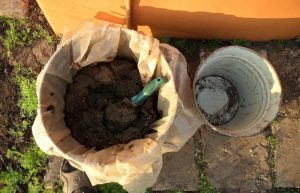 Tomatoes belong to the culture for which the introduction of fresh manure will do more harm than good. Therefore, fresh tomato litter can be used as a basis for preparation:
Tomatoes belong to the culture for which the introduction of fresh manure will do more harm than good. Therefore, fresh tomato litter can be used as a basis for preparation:
- compost
In order for the destructive substance to become a useful fertilizer, it will take about one and a half months. Compost will require sawdust. On a raised platform or in a special container, a layer of sawdust is laid out with the first layer, a layer of litter on it and sawdust on top. The height of the layers should be about the same. In order to hide the unpleasant smell, a compost pile can be covered with straw or a layer of soil. In 40-60 days, a ready-made fertilizer for tomatoes is obtained. It can be used both in autumn and in spring. Dry the mixture with a layer of about 3-5 cm in the area and dig.
- plant fertilizer solution
When preparing the infusion should strictly comply with the proportions. On a ten-liter bucket of settled water make one kilogram of fresh chicken manure, mix everything thoroughly until the manure is completely dissolved. The resulting nutritional mixture is applied immediately after preparation. Expenditure rate per plant - one liter. It is important to remember that it is possible to apply liquid dressings only on well-moistened soil, that is, after a heavy rain or high-quality artificial irrigation.
Important information!
The introduction of fresh manure without processing is possible only in the autumn period under the digging of ridges under the tomatoes, which will be planted only next year. During the winter, the litter will have time to perepret well and will be an excellent fertilizer for the nightshade.
How to use dry litter
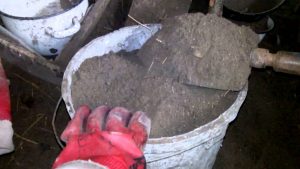 Dry litter is obtained by drying fresh in the open air. For this, a film or any other nonwoven material is spread in a sunny place, and manure is laid out on it in a thin layer. In dry and hot weather, after 15-20 days the litter dries. It is important to protect the excrement from precipitation and periodically turn it over.
Dry litter is obtained by drying fresh in the open air. For this, a film or any other nonwoven material is spread in a sunny place, and manure is laid out on it in a thin layer. In dry and hot weather, after 15-20 days the litter dries. It is important to protect the excrement from precipitation and periodically turn it over.
It is necessary to store such fertilizer in well ventilated wooden boxes. You can use it as for filling in crushed form or for the preparation of infusions.
In its pure form, dry fertilizer is applied for digging at the rate of 100 grams per square meter. To prepare the infusion litter is diluted in a ratio of 1:20 and insist for two days. For one adult plant, 700 ml of liquid fertilizer is sufficient.
How to use chicken droppings in granules
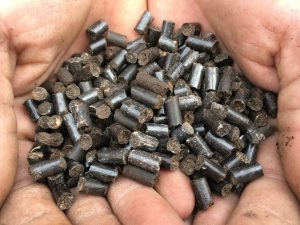 Granulated droppings are sold in a specialty store. It is a granule of different sizes with no characteristic odor. This fertilizer is obtained by instant drying at very high temperatures. Due to this, the litter is clean from pest larvae and weed seeds. Apply it like manure, dried at home. According to the instructions, the average rate of application per square meter for digging is 100-300 grams. To prepare the infusions, the granules are poured with water in the proportion of 1:50 and infused for 24 hours. On one tomato bush 0.5 liters of liquid fertilizer obtained is sufficient.
Granulated droppings are sold in a specialty store. It is a granule of different sizes with no characteristic odor. This fertilizer is obtained by instant drying at very high temperatures. Due to this, the litter is clean from pest larvae and weed seeds. Apply it like manure, dried at home. According to the instructions, the average rate of application per square meter for digging is 100-300 grams. To prepare the infusions, the granules are poured with water in the proportion of 1:50 and infused for 24 hours. On one tomato bush 0.5 liters of liquid fertilizer obtained is sufficient.
How to cook and use liquid fertilizer
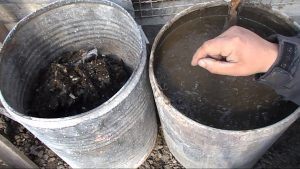 Liquid fertilizer based on chicken manure is very widely used by gardeners. This is because they are easy to prepare, and the effect of their use is noticeable after a few days. Earlier, methods for preparing liquid fertilizers based on chicken manure were already listed, we list a few of the most effective ones:
Liquid fertilizer based on chicken manure is very widely used by gardeners. This is because they are easy to prepare, and the effect of their use is noticeable after a few days. Earlier, methods for preparing liquid fertilizers based on chicken manure were already listed, we list a few of the most effective ones:
- Infusion of nettle litter
In a barrel or other convenient container, fresh chicken manure is bred in a ratio of 1:15. Then, up to half of the volume of this container add crushed leaves and stalks of young nettle. Capacity protect from precipitation and leave for 5-7 days. One tomato bush is half a liter of infusion.
- Infusion with iron vitriol
A two-liter barrel of settled water is filled with a ten-liter litter bucket and 300 grams of ferrous sulfate. Liquid fertilizer will be ready for use in 10-14 days. Ferrous sulfate will eliminate the unpleasant smell and will serve as an additional fertilizer.
Important information!
The application rate of chicken manure is 20-30 times less than that of a cow or horse.
When can you fertilize chicken droppings
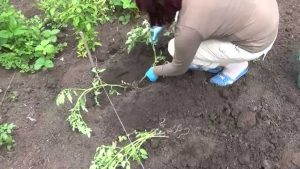 The first introduction of chicken manure for tomatoes can be made in the autumn when digging the site. This may be dry manure or compost based on it. The consumption rates have been mentioned above.
The first introduction of chicken manure for tomatoes can be made in the autumn when digging the site. This may be dry manure or compost based on it. The consumption rates have been mentioned above.
If in the autumn fertilizers were not applied or the soil is too depleted, it is allowed to add dry chicken manure directly to the planting holes. The application rate is 100 grams per square meter.
After three weeks, it is necessary to evaluate the appearance of the tomatoes if the first feeding is required. If plants have strong stems and a rich green color of leaves, then fertilization will be superfluous. This can lead to overfeeding and fattening. If the bushes by this time look pretty weak, and the leaves begin to turn yellow, this is a sure sign of a lack of nitrogen. In this case, carry out the first feeding of any liquid fertilizer.
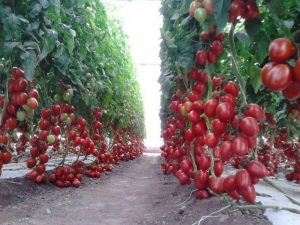 The next time, chicken manure is introduced in two or three weeks from the second feeding. It is important to have time to do this before the tomatoes enter the flowering period. At this time, the nitrogen will be superfluous and may cause discoloration and increased growth of green mass.
The next time, chicken manure is introduced in two or three weeks from the second feeding. It is important to have time to do this before the tomatoes enter the flowering period. At this time, the nitrogen will be superfluous and may cause discoloration and increased growth of green mass.
In the future, it makes sense to conduct additional feeding only for tall varieties of tomatoes, since they have a long growing season and, accordingly, they need a lot of energy for growth, flowering and fruiting at the same time. Determinant tomatoes to feed during the whole season does not make sense, as they quickly gain the required green mass at the very beginning of the season.
Tips experienced gardeners
- If there are no chickens in your own farm, then buying chicken manure is better on large poultry farms or chicken farms, so there is less risk of acquiring contaminated material. If there is no one close by, it is better to stop at a granular form of fertilizer. But in this case it is necessary to give preference to large and trusted manufacturing companies.
- Additionally, against infection with possible infections (salmonellosis, E. coli) you need to protect yourself by working only with gloves;
- Do not allow solutions or infusions to fall on the leaves of tomato bushes, as this may cause a burn. If this happens fertilizer should be washed off as soon as possible with clean water.
- Watering tomatoes with liquid fertilizer is best done not at the plant root, but between the rows. It is also recommended to do with dry formulations.
- It is always better to use a weak concentration of fertilizer, and if necessary, repeat feeding.
- It is best to store fresh chicken manure in metal barrels in a semi-liquid consistency. In order to keep as little as possible of useful substances disappear during storage, manure is mixed with garden soil in a ratio of 1: 1 or a ten-centimeter layer of soil is poured into a barrel over manure.
Chicken dung is a worthy substitute for chemical fertilizers when growing tomatoes. After studying the simple rules of applying this natural remedy, you can easily grow an environmentally friendly crop of your favorite vegetables.


